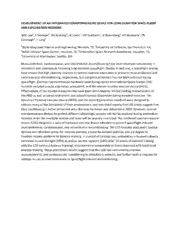
NASA Technical Reports Server (NTRS) 20100037957: Development of an Integrated Countermeasure Device for Long Duration Space Flight and Exploration Missions PDF
Preview NASA Technical Reports Server (NTRS) 20100037957: Development of an Integrated Countermeasure Device for Long Duration Space Flight and Exploration Missions
DEVELOPMENT OF AN INTEGRATED COUNTERMEASURE DEVICE FOR LONG DURATION SPACE FLIGHT AND EXPLORATION MISSIONS SMC Lee1, T Streeper2, BA Spiering1, JA Loehr1, ME Guilliams1, JJ Bloomberg3, AP Mulavara4, PR Cavanagh5, T Lang2 1Wyle Integrated Science and Engineering, Houston, TX; 2University of California, San Francisco, CA; 3NASA Johnson Space Center, Houston, TX; 4Universities Space Research Association, Houston, TX; 5University of Washington, Seattle, WA Musculoskeletal, cardiovascular, and sensorimotor deconditioning have been observed consistently in astronauts and cosmonauts following long-duration spaceflight. Studies in bed rest, a spaceflight analog, have shown that high intensity resistive or aerobic exercise attenuates or prevents musculoskeletal and cardiovascular deconditioning, respectively, but complete protection has not been achieved during spaceflight. Exercise countermeasure hardware used during earlier International Space Station (ISS) missions included a cycle ergometer, a treadmill, and the interim resistive exercise device (iRED). Effectiveness of the countermeasures may have been diminished by limited loading characteristics of the iRED as well as speed restrictions and subject harness discomfort during treadmill exercise. The Advanced Resistive Exercise Device (ARED) and the second generation treadmill were designed to address many of the limitations of their predecessors, and anecdotal reports from ISS crews suggest that their conditioning is better preserved since the new hardware was delivered in 2009. However, several countermeasure devices to protect different physiologic systems will not be practical during exploration missions when the available volume and mass will be severely restricted. The combined countermeasure device (CCD) integrates a suite of hardware into one device intended to prevent spaceflight-induced musculoskeletal, cardiovascular, and sensorimotor deconditioning. The CCD includes pneumatic loading devices with attached cables for resistive exercise, a cycle for aerobic exercise, and a 6 degree of freedom motion platform for balance training. In a proof of concept test, ambulatory untrained subjects increased muscle strength (58%) as well as aerobic capacity (26%) after 12-weeks of exercise training with the CCD (without balance training), improvements comparable to those observed with traditional exercise training. These preliminary results suggest that this CCD can concurrently improve musculoskeletal and cardiovascular conditioning in ambulatory subjects, but further work is required to validate its use as countermeasure to spaceflight-induced deconditioning.
